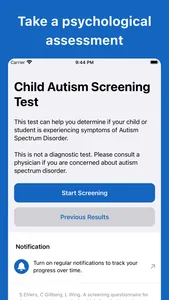Evaluate a child's risk for Autism Spectrum Disorder with a validated screening questionnaire.
Autism spectrum disorder is a spectrum of disorders with a shared core of symptoms including difficulties with social interaction, empathy, communication, and flexible behavior.
If you believe your child may be dealing with autism spectrum disorder, seek professional help immediately! Do not feel that you have to wait for a diagnosis to get your child into treatment because early intervention is very important. Ask your family doctor or pediatrician to refer you immediately to an autism specialist or team of specialists for a comprehensive evaluation.
Disclaimer: This test is NOT a diagnostic test. A diagnosis can only be provided by a qualified healthcare professional. Please consult a physician or mental health professional if you are concerned about a child's mental health.
S Ehlers, C Gillberg, L Wing. A screening questionnaire for Asperger syndrome and other high-functioning autism spectrum disorders in school age children. J Autism Dev Disord. 1999; 29(2): 129–141.
Autism spectrum disorder is a spectrum of disorders with a shared core of symptoms including difficulties with social interaction, empathy, communication, and flexible behavior.
If you believe your child may be dealing with autism spectrum disorder, seek professional help immediately! Do not feel that you have to wait for a diagnosis to get your child into treatment because early intervention is very important. Ask your family doctor or pediatrician to refer you immediately to an autism specialist or team of specialists for a comprehensive evaluation.
Disclaimer: This test is NOT a diagnostic test. A diagnosis can only be provided by a qualified healthcare professional. Please consult a physician or mental health professional if you are concerned about a child's mental health.
S Ehlers, C Gillberg, L Wing. A screening questionnaire for Asperger syndrome and other high-functioning autism spectrum disorders in school age children. J Autism Dev Disord. 1999; 29(2): 129–141.
Show More


